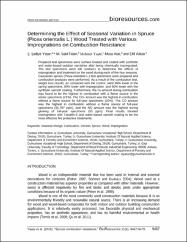Determining the Effect of Seasonal Variation in Spruce (Picea orientalis L.) Wood Treated with Various Impregnations on Combustion Resistance
Access
Attribution 3.0 United Statesinfo:eu-repo/semantics/openAccesshttp://creativecommons.org/licenses/by/3.0/us/Date
2016Access
Attribution 3.0 United Statesinfo:eu-repo/semantics/openAccesshttp://creativecommons.org/licenses/by/3.0/us/Metadata
Show full item recordAbstract
Prepared test specimens were surface treated and coated with synthetic and water-based outdoor varnishes after being chemically impregnated. The test specimens were left outdoors to determine the effects of impregnation and treatment on the wood during each of the four seasons. Caucasian spruce (Picea orientalis L.) test specimens were prepared and combustion analyses were performed. As a result of the combustion test, weight loss results, as compared with the control, were 89% lower in the spring specimens, 90% lower with impregnation, and 90% lower with the synthetic varnish coating. Furthermore, the O-2 amount during combustion was found to be the highest in combustion with a flame source in the winter specimens (21%). The CO2 amount was the highest in combustion without a flame source for full-year specimens (20%). The CO amount was the highest in combustion without a flame source of full-year specimens (31,787 ppm), and the NO amount was the highest during glowing of full-year specimens (55 ppm). Final results showed impregnation with Tanalith-E and water-based varnish coating to be the most effective fire protective treatments.
Volume
11Issue
4Collections
The following license files are associated with this item:



















